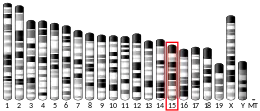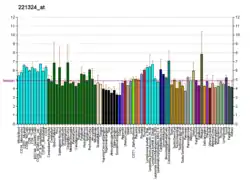TAS2R1
Taste receptor type 2 member 1 (TAS2R1/T2R1) is a protein that in humans is encoded by the TAS2R1 gene.[5][6][7] It belongs to the G protein-coupled receptor (GPCR) family and is related to class A-like GPCRs, they contain 7 transmembrane helix bundles and short N-terminus loop.[8] Furthermore, TAS2R1 is member of the 25 known human bitter taste receptors, which enable the perception of bitter taste in the mouth cavity. Increasing evidence indicates a functional role of TAS2Rs in extra-oral tissues.[9]
Expression and function
Extra-oral roles of TAS2Rs
Bitter taste receptors are expressed in taste receptor cells, which organized into taste buds on the papillae of the tongue and palate epithelium.
In addition, TAS2Rs were found to be expressed in extra-oral tissues, e.g. brain, lungs, gastrointestinal tract, etc.[9] So far, less is known about their function however, for example it was shown that:
Extra-oral roles of TAS2R1
- TAS2R1, TAS2R4, TAS2R10, TAS2R38 and TAS2R49 were found to be down-regulated in breast cancer cells[12].
- TAS2R1, causes vasoconstrictor responses in the pulmonary circuit and relaxation in the airways[13].
Structure of TAS2R1 receptor
Based on a recent homology model from BitterDB[14][15] several conserved motifs, which are counterparts to Class A GPCRs[8] were found:
- Transmembrane helix 1: N1.50xxI1.53
- Transmembrane helix 2: L2.46xxxR2.50
- Transmembrane helix 3: F3.49Y3.50xxK3.53
- Transmembrane helix 5: P5.50
- Transmembrane helix 6: F6.44xxxY6.46
- Transmembrane helix 7: H7.49S7.50xxL7.53
Numbering is according to the Balleros-Weinstein[16] system.
Unlike in Class A GPCRs, in transmembrane helix 4 no DRY[17] motif was found as well as position 6.50 is not conserved.
TAS2R1 gene
This gene encodes a member of a family of candidate taste receptors that are members of the G protein-coupled receptor superfamily and that are specifically expressed by taste receptor cells of the tongue and palate epithelia. This intronless taste receptor gene encodes a 7-transmembrane receptor protein, functioning as a bitter taste receptor.
Transcription Factors
So far, AML1a, AP-1, AREB6, FOXL1, IRF-7A, Lmo2, NF-E2, NF-E2 p45 were found as the top transcription factor binding sites by QIAGEN in the TAS2R1 gene promoter.
Mutagenesis data
Several mutations have been shown to influence binding of a ligand to TAS2R1 (based on BitterDB):
| Receptor region | BW number | Residue | Reference |
| TM1 | 1.5 | N24 | doi: 10.1021/acs.jctc.5b00472 doi: 10.1074/jbc.M111.246983 |
| TM1 | 1.53 | I27 | doi: 10.1021/acs.jctc.5b00472 doi: 10.1074/jbc.M111.246983 |
| TM2 | 2.5 | R55 | doi: 10.1021/acs.jctc.5b00472 doi: 10.1074/jbc.M111.246983 |
| TM2 | 2.56 | F61 | doi: 10.1074/jbc.M111.246983 |
| TM2 | 2.61 | N66 | doi: 10.3389/fmolb.2017.00063 doi: 10.1021/acs.jctc.5b00472 doi: 10.1016/bs.mcb.2015.10.005 doi: 10.1074/jbc.M111.246983 |
| ECL1 | E74 | doi: 10.3389/fmolb.2017.00063 | |
| TM3 | 3.32 | L85 | doi: 10.1016/bs.mcb.2015.10.005 doi: 10.3109/10799893.2011.578141 |
| TM3 | 3.33 | L86 | doi: 10.1016/bs.mcb.2015.10.005 doi: 10.3109/10799893.2011.578141 |
| TM3 | 3.36 | N89 | doi: 10.1016/bs.mcb.2015.10.005 doi: 10.1074/jbc.M111.246983 doi: doi: 10.1021/acs.jctc.5b00472 doi: 10.1074/jbc.M111.246983 |
| TM3 | 3.37 | E90 | doi: 10.1016/bs.mcb.2015.10.005 doi: 10.3109/10799893.2011.578141 |
| TM3 | 3.41 | W94 | doi: 10.1021/acs.jctc.5b00472 doi: 10.1074/jbc.M111.246983 |
| TM3 | 3.46 | L99 | doi: 10.1021/acs.jctc.5b00472 doi: 10.1074/jbc.M111.246983 |
| TM5 | 5.46 | E182 | doi: 10.1016/bs.mcb.2015.10.005 doi: 10.3109/10799893.2011.578141 |
| TM5 | 5.61 | L197 | doi: 10.1021/acs.jctc.5b00472 doi: 10.1074/jbc.M111.246983 |
| TM5 | 5.64 | S200 | doi: 10.1021/acs.jctc.5b00472 doi: 10.1074/jbc.M111.246983 |
| TM5 | 5.65 | L201 | doi: 10.1021/acs.jctc.5b00472 doi: 10.1074/jbc.M111.246983 |
| TM7 | 7.39 | I263 | doi: 10.1016/bs.mcb.2015.10.005 doi: 10.3109/10799893.2011.578141 |
| TM7 | 7.49 | H273 | doi: 10.1021/acs.jctc.5b00472 doi: 10.1074/jbc.M111.246983 |
| TM7 | 7.53 | L277 | doi: 10.1021/acs.jctc.5b00472 doi: 10.1074/jbc.M111.246983 |
| TM7 | 7.54 | I278 | doi: 10.1021/acs.jctc.5b00472 doi: 10.1074/jbc.M111.246983 |
Ligands
Up to now, 39 ligands for T2R1 were identified in BitterDB, among them L-amino acids, peptides, humulones, small molecules etc.[18]
See also
References
- GRCh38: Ensembl release 89: ENSG00000169777 - Ensembl, May 2017
- GRCm38: Ensembl release 89: ENSMUSG00000045267 - Ensembl, May 2017
- "Human PubMed Reference:". National Center for Biotechnology Information, U.S. National Library of Medicine.
- "Mouse PubMed Reference:". National Center for Biotechnology Information, U.S. National Library of Medicine.
- Adler E, Hoon MA, Mueller KL, Chandrashekar J, Ryba NJ, Zuker CS (Apr 2000). "A novel family of mammalian taste receptors". Cell. 100 (6): 693–702. doi:10.1016/S0092-8674(00)80705-9. PMID 10761934. S2CID 14604586.
- Matsunami H, Montmayeur JP, Buck LB (Apr 2000). "A family of candidate taste receptors in human and mouse". Nature. 404 (6778): 601–4. Bibcode:2000Natur.404..601M. doi:10.1038/35007072. PMID 10766242. S2CID 4336913.
- "Entrez Gene: TAS2R1 taste receptor, type 2, member 1".
- Di Pizio, Antonella; Levit, Anat; Slutzki, Michal; Behrens, Maik; Karaman, Rafik; Niv, Masha Y. (2016), "Comparing Class A GPCRs to bitter taste receptors", Methods in Cell Biology, Elsevier, 132: 401–427, doi:10.1016/bs.mcb.2015.10.005, ISBN 9780128035955, PMID 26928553
- Lu, Ping; Zhang, Cheng-Hai; Lifshitz, Lawrence M.; ZhuGe, Ronghua (2017-01-04). "Extraoral bitter taste receptors in health and disease". The Journal of General Physiology. 149 (2): 181–197. doi:10.1085/jgp.201611637. ISSN 0022-1295. PMC 5299619. PMID 28053191.
- Deshpande, Deepak A; Wang, Wayne C H; McIlmoyle, Elizabeth L; Robinett, Kathryn S; Schillinger, Rachel M; An, Steven S; Sham, James S K; Liggett, Stephen B (2010-10-24). "Bitter taste receptors on airway smooth muscle bronchodilate by localized calcium signaling and reverse obstruction". Nature Medicine. 16 (11): 1299–1304. doi:10.1038/nm.2237. ISSN 1078-8956. PMC 3066567. PMID 20972434.
- Liszt, Kathrin Ingrid; Ley, Jakob Peter; Lieder, Barbara; Behrens, Maik; Stöger, Verena; Reiner, Angelika; Hochkogler, Christina Maria; Köck, Elke; Marchiori, Alessandro (2017-07-10). "Caffeine induces gastric acid secretion via bitter taste signaling in gastric parietal cells". Proceedings of the National Academy of Sciences. 114 (30): E6260–E6269. doi:10.1073/pnas.1703728114. ISSN 0027-8424. PMC 5544304. PMID 28696284.
- Singh, Nisha; Chakraborty, Raja; Bhullar, Rajinder Pal; Chelikani, Prashen (April 2014). "Differential expression of bitter taste receptors in non-cancerous breast epithelial and breast cancer cells". Biochemical and Biophysical Research Communications. 446 (2): 499–503. doi:10.1016/j.bbrc.2014.02.140. ISSN 0006-291X. PMID 24613843.
- Upadhyaya, Jasbir D.; Singh, Nisha; Sikarwar, Anurag S.; Chakraborty, Raja; Pydi, Sai P.; Bhullar, Rajinder P.; Dakshinamurti, Shyamala; Chelikani, Prashen (2014-10-23). "Dextromethorphan Mediated Bitter Taste Receptor Activation in the Pulmonary Circuit Causes Vasoconstriction". PLOS ONE. 9 (10): e110373. Bibcode:2014PLoSO...9k0373U. doi:10.1371/journal.pone.0110373. ISSN 1932-6203. PMC 4207743. PMID 25340739.
- Wiener, Ayana; Shudler, Marina; Levit, Anat; Niv, Masha Y. (2011-09-22). "BitterDB: a database of bitter compounds". Nucleic Acids Research. 40 (D1): D413–D419. doi:10.1093/nar/gkr755. ISSN 1362-4962. PMC 3245057. PMID 21940398.
- Dagan-Wiener, Ayana; Di Pizio, Antonella; Nissim, Ido; Bahia, Malkeet S; Dubovski, Nitzan; Margulis, Eitan; Niv, Masha Y (2018-10-24). "BitterDB: taste ligands and receptors database in 2019". Nucleic Acids Research. 47 (D1): D1179–D1185. doi:10.1093/nar/gky974. ISSN 0305-1048. PMC 6323989. PMID 30357384.
- Ballesteros, Juan A.; Weinstein, Harel (1995), "[19] Integrated methods for the construction of three-dimensional models and computational probing of structure-function relations in G protein-coupled receptors", Methods in Neurosciences, Elsevier, pp. 366–428, doi:10.1016/s1043-9471(05)80049-7, ISBN 9780121852955
- Rovati, G. E.; Capra, V.; Neubig, R. R. (2007-01-12). "The Highly Conserved DRY Motif of Class A G Protein-Coupled Receptors: Beyond the Ground State". Molecular Pharmacology. 71 (4): 959–964. doi:10.1124/mol.106.029470. ISSN 0026-895X. PMID 17192495. S2CID 15536186.
- "hTAS2R1". BitterDB. The Hebrew University of Jerusalem.
Further reading
- Kinnamon SC (2000). "A plethora of taste receptors". Neuron. 25 (3): 507–10. doi:10.1016/S0896-6273(00)81054-5. PMID 10774719.
- Margolskee RF (2002). "Molecular mechanisms of bitter and sweet taste transduction". J. Biol. Chem. 277 (1): 1–4. doi:10.1074/jbc.R100054200. PMID 11696554.
- Montmayeur JP, Matsunami H (2002). "Receptors for bitter and sweet taste". Curr. Opin. Neurobiol. 12 (4): 366–71. doi:10.1016/S0959-4388(02)00345-8. PMID 12139982. S2CID 37807140.
- Chandrashekar J, Mueller KL, Hoon MA, Adler E, Feng L, Guo W, Zuker CS, Ryba NJ (2000). "T2Rs function as bitter taste receptors". Cell. 100 (6): 703–11. doi:10.1016/S0092-8674(00)80706-0. PMID 10761935. S2CID 7293493.
- Firestein S (2000). "The good taste of genomics". Nature. 404 (6778): 552–3. doi:10.1038/35007167. PMID 10766221. S2CID 35741332.
- Zhang Y, Hoon MA, Chandrashekar J, Mueller KL, Cook B, Wu D, Zuker CS, Ryba NJ (2003). "Coding of sweet, bitter, and umami tastes: different receptor cells sharing similar signaling pathways". Cell. 112 (3): 293–301. doi:10.1016/S0092-8674(03)00071-0. PMID 12581520. S2CID 718601.
- Fischer A, Gilad Y, Man O, Pääbo S (2005). "Evolution of bitter taste receptors in humans and apes". Mol. Biol. Evol. 22 (3): 432–6. doi:10.1093/molbev/msi027. PMID 15496549.
- Go Y, Satta Y, Takenaka O, Takahata N (2006). "Lineage-specific loss of function of bitter taste receptor genes in humans and nonhuman primates". Genetics. 170 (1): 313–26. doi:10.1534/genetics.104.037523. PMC 1449719. PMID 15744053.
This article incorporates text from the United States National Library of Medicine, which is in the public domain.




